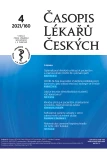How Czech and Slovak vascular surgeons and nephrologists accept recommendations of the European Society of Vascular Surgery – survey study
Authors:
Ondřej Molva 1; Michal Kútik 1; Peter Baláž 1,2
Authors‘ workplace:
Chirurgická klinika 3. LF UK a FNKV, Praha
1; Národný ústav srdcových a cievnych chorôb, a. s., Nové Mesto, SR
2
Published in:
Čas. Lék. čes. 2021; 160: 143-148
Category:
Original Articles
Overview
Arteriovenous access (AVA) is the cornerstone for the long-term haemodialysis treatment in the patient with end-stage kidney disease. Nowadays, European Society of Vascular Surgery (ESVS) has presented clinical guidelines regarding all aspects of AVA. The aim of the study was to identify acceptance rate of selected ESVS recommendations among Czech and Slovak vascular surgeons and nephrologists. We carried out a prospective analysis of 7 questions from an online survey collected from January to February 2020. 211 (33 %) of 646 participants responded to the survey. Questions were divided into two groups, general and surgical. General questions were for both nephrologist and vascular surgeons. Surgical questions were evaluated only for vascular surgeons. In the first group 190 (90 %) respondents accept, that extremity dominance is important for location of AVA, 186 (89 %) agree that clinically suspected venous hypertension/central vein occlusion is an indication for fistulography, 111 (53 %) agree, that indwelling central venous catheter/pacemaker is an indication for AVA creation in the opposite side. In the second group, 50 (57 %) agree that patients before AVA creation should be examined with a tourniquet prior to surgery, 45 (51 %) agree, that pre-operative ultrasonography mapping is recommended, 66 (75 %) agree, that the inner radial artery and the cephalic vein should be more than 2.0 mm, and only 9 (10 %) respondents agree that regional anaesthesia is preferred over local anaesthesia for AVA creation.
In both Czech and Slovak Republic, preoperative planning is not uniform and ESVS recommendations for AVA are accepted at the level of 57 %.
Keywords:
arteriovenous fistula – vascular access – haemodialysis – survey
Sources
1. Brescia MJ, Cimino JE, Appel K, Hurwich BJ. Chronic Hemodialysis Using Venipuncture and a Surgically Created Arteriovenous Fistula. N Engl J Med 1966; 275 : 1089–1092.
2. Schinstock CA, Albright RC, Williams AW, et al. Outcomes of Arteriovenous Fistula Creation after the Fistula First Initiative. J Am Soc Nephrol 2011; 6 : 1996–2002.
3. Schmidli J, Widmer MK, Basile C, et al. Editor’s Choice – Vascular Access: 2018 Clinical Practice Guidelines of the European Society for Vascular Surgery (ESVS). Eur J Vasc Endovasc Surg 2018; 55 : 757–818.
4. Lok CE, Huber TS, Lee T, et al. KDOQI Clinical Practice Guideline for Vascular Access: 2019 Update. Am J Kidney Dis 2020; 75: S1–S164.
5. Shenoy S, Darcy M. Ultrasound as a tool for preoperative planning, monitoring, and interventions in dialysis arteriovenous access. Am J Roentgenol 2013; 201: W539–W543.
6. Rychlík I. Komentář k článku: Který pacient by měl být odeslán k založení fistule? Průzkum názorů nefrologů. Postgraduální nefrologie 2010; 8 : 95–96.
7. Malovrh M. Native arteriovenous fistula: preoperative evaluation. Am J Kidney Dis 2002; 39 : 1218–1225.
8. Woo K. Arteriovenous fistula creation for hemodialysis and its complications. UpToDate, 2020 May 27. Dostupné na: www.uptodate.com/contents/arteriovenous - fistula-creation-for-hemodialysis-and-its-complications
9. Sidawy AN, Spergel LM, Besarab A, et al. The Society for Vascular Surgery: Clinical practice guidelines for the surgical placement and maintenance of arteriovenous hemodialysis access. J Vasc Surg 2008; 48: S2–S25.
10. Gallieni M, Hollenbeck M, Inston N, et al. Clinical practice guideline on periand postoperative care of arteriovenous fistulas and grafts for haemodialysis in adults. Nephrol Dial Transplant 2020; 35 : 2203–2203.
11. Wasse H. Place of percutaneous fistula devices in contemporary management of vascular access. J Am Soc Nephrol 2019; 14 : 938–940.
12. Schults J, Kleidon T, Chopra V, et al. International recommendations for a vascular access minimum dataset: a Delphi consensus-building study. BMJ Qual Saf 2020; bmjqs-2020-011274.
13. Baláž P, Hanko J, Magowan H, et al. The arteriovenous access stage (AVAS) classification. Clin Kidney J 2020; 14 : 1747–1751.
14. Chan CT, Blankestijn PJ, Dember LM, et al. Dialysis initiation, modality choice, access, and prescription: conclusions from a Kidney Disease: Improving Global Outcomes (KDIGO) Controversies Conference. Kidney Int 2019; 96 : 37–47.
15. ESC. Clinical Practice Guidelines. European Society of Cardiology, 2020. Dostupné na: www.escardio.org/Guidelines/Clinical-Practice-Guidelines).
Labels
Addictology Allergology and clinical immunology Angiology Audiology Clinical biochemistry Dermatology & STDs Paediatric gastroenterology Paediatric surgery Paediatric cardiology Paediatric neurology Paediatric ENT Paediatric psychiatry Paediatric rheumatology Diabetology Pharmacy Vascular surgery Pain management Dental HygienistArticle was published in
Journal of Czech Physicians

2021 Issue 4
Most read in this issue
- Optimizing clinical approaches to COVID-19 patients in primary care
- COVID-19-free workplace: Measuring the level of antibodies against coronavirus as a basis for testing strategy in companies
- What is the immunity of high school students to coronavirus?
- Software used in emergency medical services
